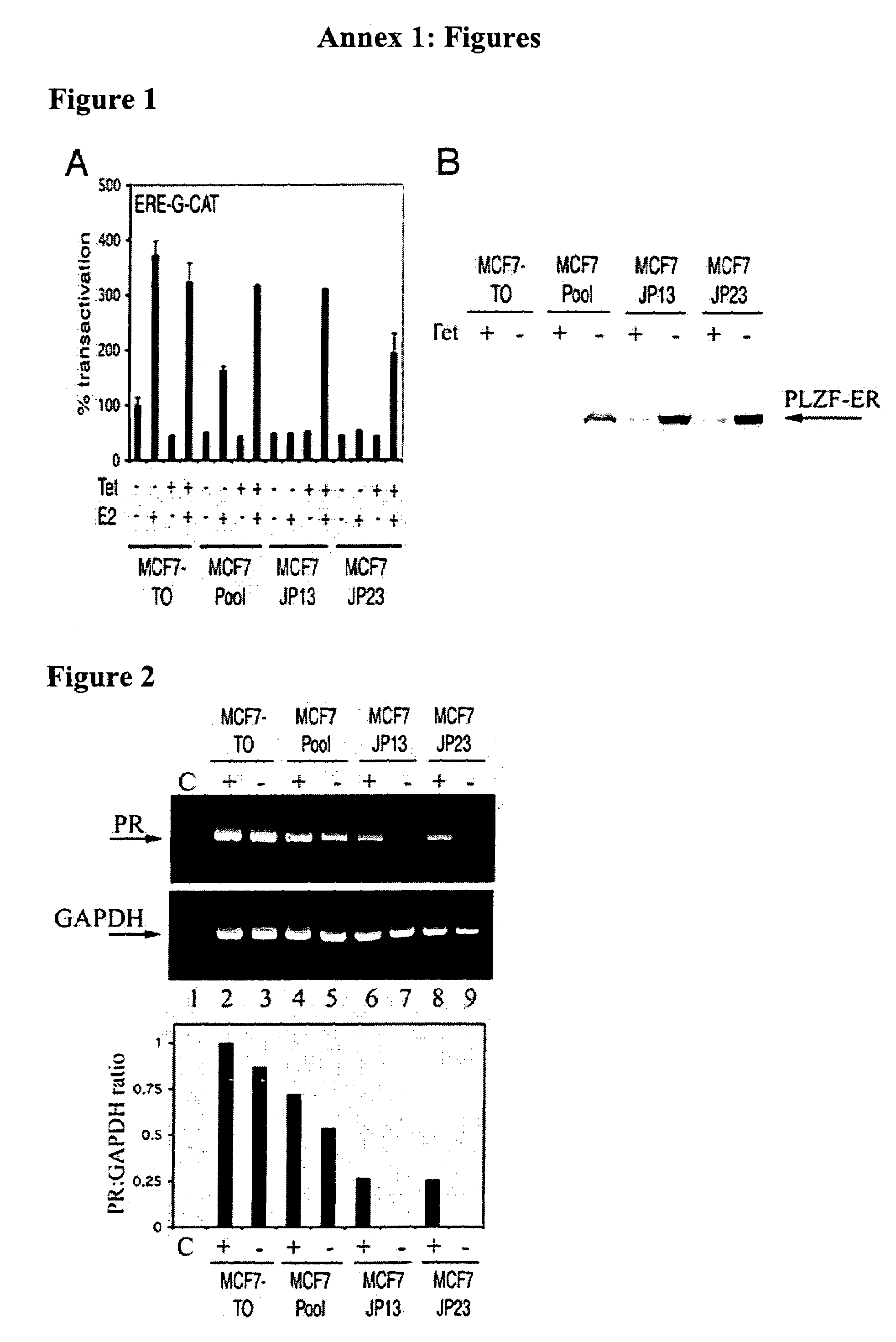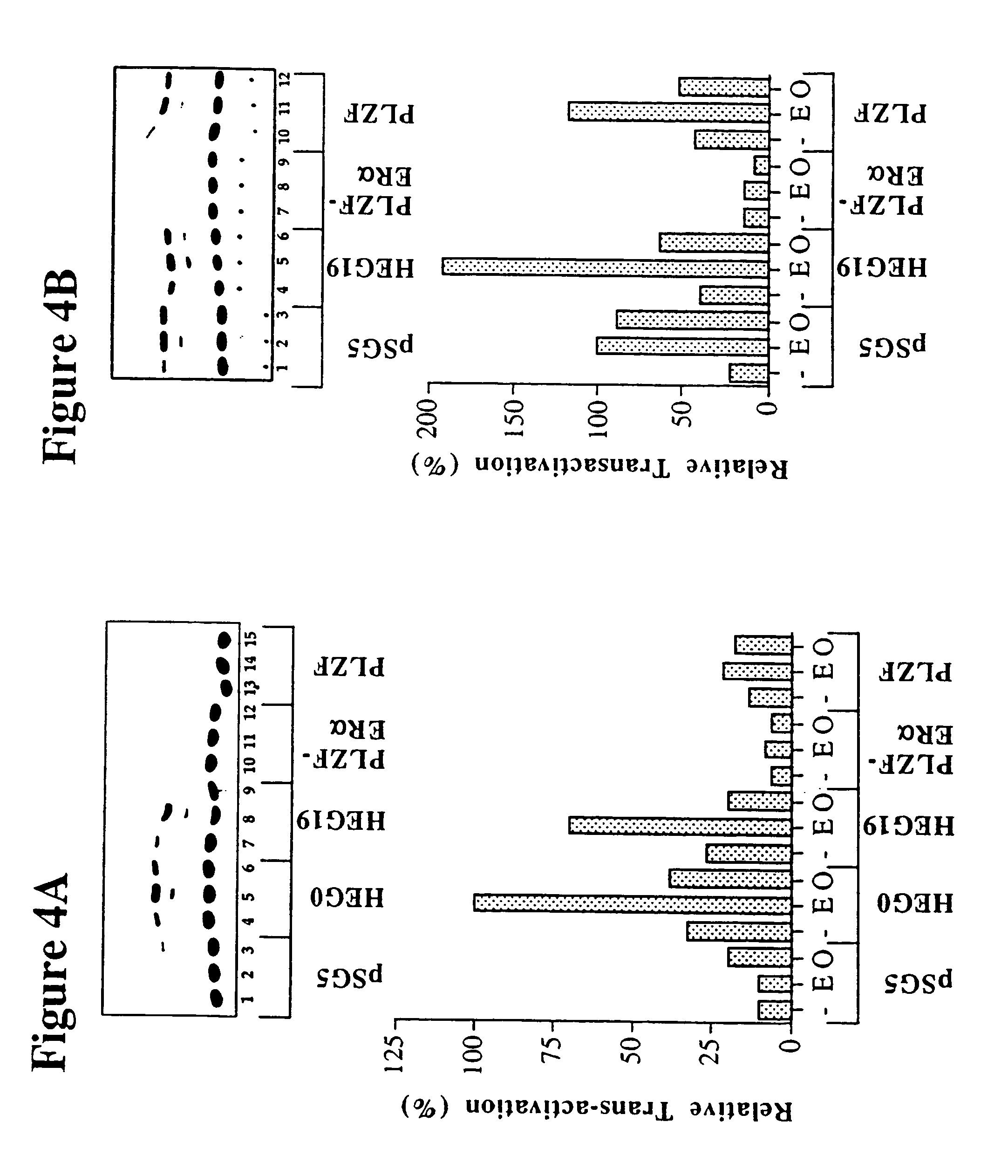Control of gene expression
a gene expression and control technology, applied in the field of gene expression control, can solve the problems of difficult implementation of antisense- and ribozyme-based techniques, difficult to perform targeted gene deletion in plants, and difficult to apply, and achieve the effect of suppressing the expression of a selected gen
- Summary
- Abstract
- Description
- Claims
- Application Information
AI Technical Summary
Benefits of technology
Problems solved by technology
Method used
Image
Examples
example 1
Construction and Use of PLZF-ERα Gene Fusion
[0149]Work was carried out to produce an analogue of the PLZF-RARα gene fusion found in acute promyelocytic leukaemia (Guidez et al (1998) Blood 91, 2634–2642), in which the RARα portion was replaced by an equivalent region of the human estrogen receptor (ERα). To do this, a 1392 bp region of PLZF coding region was amplified by PCR from a full length cDNA clone using a generic oligonucleotide primer to 5′ flanking cloning vector sequence (T7 primer) and a primer complementary to PLZF sequences encompassed by bases 1441–1446 of the sequence of Chen et al (1993) EMBO J. 12, 1161–1167, with additional bases added to the 3′ end, so as to introduce an in-frame XhoI restriction enzyme site (Primer PLZF R; ccgctcgagCTGAATGAGCCAGTAAGTGCATTCTC) (SEQ ID NO:1). Similarly, a 1407 bp region of a human ER RARα cDNA clone (HEG0; Tora et al (1989) EMBO J. 8, 1981–1986) was amplified by PCR using primers which introduced an in frame XhoI site into 5′ codin...
example 2
Construction of PLZF-AR Gene Fusion and its Use
[0158]A second analogue of the PLZF-RARα gene fusion was produced in which the RARα portion was replaced by an equivalent region of the human androgen receptor (AR). A 1146 bp region of a human AR cDNA clone (Tilley et al 1989 Proc. Natl. Acad. Sci. USA 86, 327–331) was amplified by PCR using primers which introduced an in frame XhoI site into the 5′ coding region and a BamHI site immediately following the stop codon (Primers AR F1, ggagctcgagggTTGGAGACTGCCAGGGACC (SEQ ID NO:4) and AR R1; gtgaggatccTCACTGGGTGTGGAAATAGATGG (SEQ ID NO:5)). The AR PCR product was restriction enzyme digested with XhoI and BanHI and ligated with XhoI / BanHI digested PLZF-ER to replace the ER portion with AR. The ligation product was used to transform E. coli bacteria and plasmid DNA prepared from individual clones. Recombinant pSG5 plasmids containing PLZF-AR gene fusion DNA were initially identified by restriction enzyme digestion and were subsequently confi...
example 3
Suppression of Androgen Receptor-Mediated Transcription in a Prostate Cancer Patient
[0161]A plasmid vector is produced which encodes the PLZF-AR fusion protein as described in Example 2 under the control of the PSA gene promoter which allows for selective expression in prostate tissue. The plasmid is prepared in a sterile and pyrogen-free form and is formulated into liposomes. The plasmid DNA-containing liposomes are administered into the vicinity of the prostate. Plasmid DNA is taken up by the prostate cancer cells and androgen receptor-mediated transcription is suppressed selectively in prostate cells.
PUM
 Login to View More
Login to View More Abstract
Description
Claims
Application Information
 Login to View More
Login to View More - R&D
- Intellectual Property
- Life Sciences
- Materials
- Tech Scout
- Unparalleled Data Quality
- Higher Quality Content
- 60% Fewer Hallucinations
Browse by: Latest US Patents, China's latest patents, Technical Efficacy Thesaurus, Application Domain, Technology Topic, Popular Technical Reports.
© 2025 PatSnap. All rights reserved.Legal|Privacy policy|Modern Slavery Act Transparency Statement|Sitemap|About US| Contact US: help@patsnap.com



